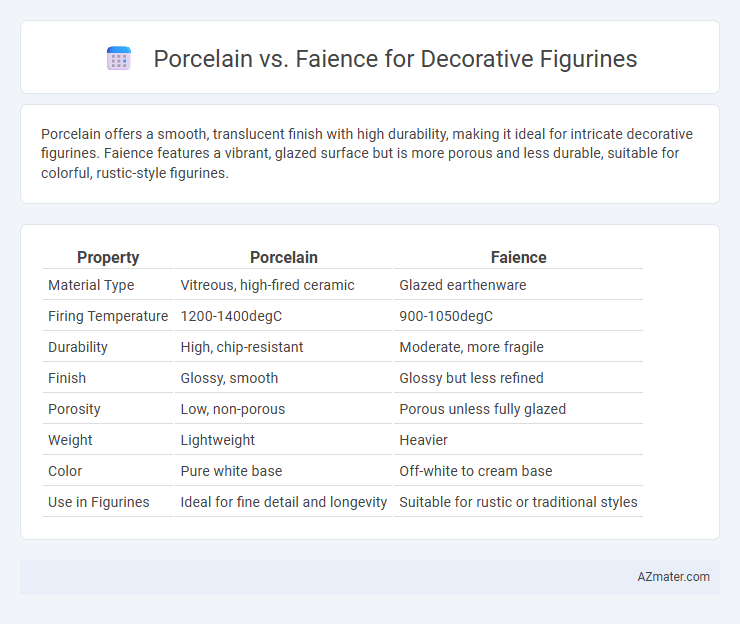Porcelain offers a smooth, translucent finish with high durability, making it ideal for intricate decorative figurines. Faience features a vibrant, glazed surface but is more porous and less durable, suitable for colorful, rustic-style figurines.
Table of Comparison
| Property | Porcelain | Faience |
|---|---|---|
| Material Type | Vitreous, high-fired ceramic | Glazed earthenware |
| Firing Temperature | 1200-1400degC | 900-1050degC |
| Durability | High, chip-resistant | Moderate, more fragile |
| Finish | Glossy, smooth | Glossy but less refined |
| Porosity | Low, non-porous | Porous unless fully glazed |
| Weight | Lightweight | Heavier |
| Color | Pure white base | Off-white to cream base |
| Use in Figurines | Ideal for fine detail and longevity | Suitable for rustic or traditional styles |
Introduction to Decorative Figurines
Decorative figurines crafted from porcelain exhibit a smooth, translucent finish achieved through high-temperature firing, enhancing detail and durability. Faience, a type of glazed earthenware, offers vibrant colors and a more porous texture due to low-temperature firing, making it distinct yet less durable than porcelain. Collectors often prefer porcelain figurines for their refined craftsmanship and longevity, while faience appeals for its historical and artisanal aesthetic.
What is Porcelain?
Porcelain is a high-quality ceramic material made from kaolin clay, firing at temperatures above 1,200degC, resulting in a dense, white, translucent finish highly prized for decorative figurines due to its durability and fine detail. Its vitrification process makes porcelain non-porous and resistant to chipping, ideal for intricate designs and smooth surfaces. Compared to faience, porcelain offers superior strength and a more refined aesthetic, making it a preferred choice for collectors and artisans in decorative arts.
What is Faience?
Faience is a glazed non-clay ceramic material made from finely ground quartz or sand, mixed with a small amount of clay and coated with a vivid, glass-like glaze. Unlike porcelain, which is fired at extremely high temperatures to achieve a dense, translucent finish, faience is fired at lower temperatures, resulting in a slightly porous texture and vibrant colors ideal for ornamental details. This material has been historically used for decorative figurines and tiles due to its bright glaze and affordability compared to the more delicate and refined porcelain.
Key Material Differences
Porcelain for decorative figurines is characterized by its fine, dense, and white vitrified material made from kaolin clay, resulting in high durability and a smooth, translucent finish. Faience, conversely, is a glazed earthenware composed of coarser clay with a porous body beneath its tin-based opaque glaze, offering more vibrant colors but less strength and translucency. These material differences influence the figurines' texture, weight, and longevity, making porcelain preferred for delicate, detailed pieces and faience suitable for colorful, rustic designs.
Comparison of Appearance and Finish
Porcelain figurines exhibit a smooth, glossy finish with a translucent quality that enhances fine detail and vibrant colors, making them ideal for elegant decorative pieces. Faience figurines, made from glazed earthenware, offer a more rustic, matte or semi-gloss appearance with slightly coarser texture and less translucency, resulting in a charming, artisanal aesthetic. The durability and finesse of porcelain create a refined look, while faience provides a traditional, handcrafted appeal suited for vintage or rustic decor styles.
Durability and Longevity
Porcelain decorative figurines boast superior durability and longevity due to their dense, vitrified structure that resists chipping and moisture damage, making them ideal for long-term display. Faience, a type of tin-glazed pottery, is more porous and fragile, leading to increased susceptibility to cracks, chips, and color fading over time. Collectors and decorators seeking enduring figurines often prefer porcelain for its robustness and sustained aesthetic appeal.
Artistic Versatility and Detail
Porcelain offers exceptional artistic versatility and fine detail due to its smooth, translucent surface and high firing temperature, allowing intricate designs and delicate features in decorative figurines. Faience, a tin-glazed earthenware, provides vibrant color potential with a glossy finish but has lower durability and less precision in fine details compared to porcelain. Collectors and artists often prefer porcelain for its ability to capture minute expressions and complex textures in figurines.
Cost and Availability
Porcelain decorative figurines typically cost more due to their fine, durable material and labor-intensive production, while faience pieces are generally more affordable and accessible, often found in specialized craft markets. Porcelain's availability can be limited to high-end retailers and collectors, contrasting with faience, which is widely produced and easier to acquire in various art shops and online platforms. The cost difference reflects porcelain's superior quality and longevity against faience's decorative appeal and budget-friendly nature.
Best Uses for Porcelain Figurines
Porcelain figurines excel in intricate detailing and durability, making them ideal for fine decorative displays and collector's showcases where precision craftsmanship is valued. Their translucent quality and smooth glaze enhance artistic appeal, perfectly suited for elegant home decor and museum-quality pieces. Porcelain's resistance to chipping and moisture also makes it preferable for heirloom collectibles displayed in well-lit, indoor environments.
Best Uses for Faience Figurines
Faience figurines excel in decorative use due to their vibrant glazes and historical significance in ancient art, making them ideal for collectors seeking unique, colorful pieces with a rustic charm. They are best suited for indoor display environments where their glazed surfaces can be preserved without risk of damage from moisture or extreme temperatures. Porcelain, while more refined and durable, is often preferred for detailed craftsmanship and high-end finishes, whereas faience offers a more affordable, culturally rich alternative that enhances rustic or eclectic decorative themes.

Infographic: Porcelain vs Faience for Decorative Figurine
 azmater.com
azmater.com